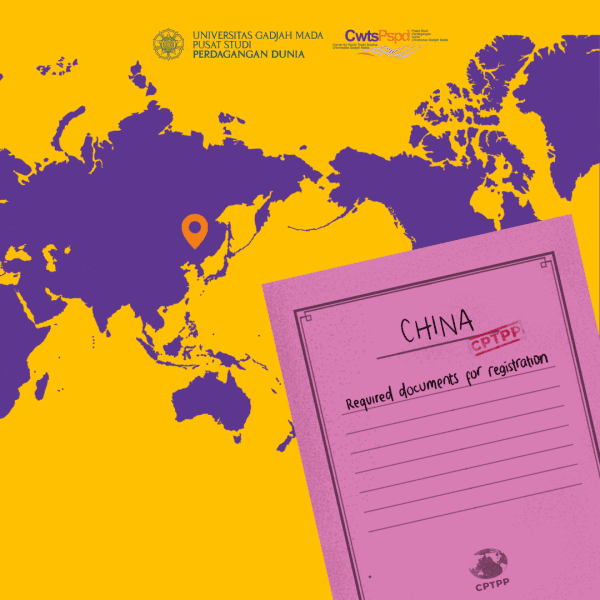China’s Proposal to Join CPTPP: Between Economic Cooperation and Balance of Power Calculation

Writer :
Lukas Andri Surya Singarimbun
Writer, Center for World Trade Studies Universitas Gadjah Mada.

Editor:
Ameral Rizkovic
Website Manager, Center for World Trade Studies Universitas Gadjah Mada.

Editor:
Nabila Asysyfa Nur
Website Content Manager, Center for World Trade Studies Universitas Gadjah Mada.

Illustrator:
Narinda Marsha Paramastuti
Graphic Designer, Center for World Trade Studies Universitas Gadjah Mada.
On September 16, 2021, China has officially submitted the CPTPP (Comprehensive and Progressive Agreement for Trans-Pacific Partnership) – a forum that consists of 11 nations that agreed in 2018 – membership proposal. This proposal surprises many as Beijing submitted the membership proposal when not only the geopolitical tension particularly with the US is being vigorously debated but also because it is done towards the regional cooperation that is principally forged to encounter China’s increasing influence in the international economy and trade. The process of being a CPTPP member, regardless of being accepted or denied by other CPTPP members, obviously has shown a clear geo-economy tension in the Indo-Pacific region. Despite the lucrative economic potential of China’s membership, the international political rivalry is and will dominate China’s proposal in joining CPTPP.
CPTPP is the succession of regional economic cooperation initiated by the US called TPP (Trans-Pacific Partnership). TPP not only aims to enhance the trade and investment cooperation amongst the members but also to revive the US leadership in the Indo-Pacific region. Furthermore, it also forged to counter China’s expanding economic influence in the region. Concurrently with the formation of TPP, China was also negotiating the trade agreement called RCEP (Regional Comprehensive Economy Partnership), a trade agreement that involves all ASEAN countries such as Japan, South Korea, Australia, and New Zealand, which was agreed upon in November 2020 and effective from January 2022. For many US foreign policy analysts, the success of the TPP negotiation will enhance Washington’s strategic leverage as Beijing’s presence is increasing rapidly in the Asia-Pacific region.
Despite being the initiator of TPP during the Obama administration, his successor, President Donald Trump with his “American First” approach formally left the negotiation process. His administration argued that joining TPP was futile and overburdened the US itself (Narine, 2018). However, in spite of the US withdrawal, the remaining countries are continuing the negotiation and eventually agreed upon CPTPP. Recently, there are some countries that propose to join CPTPP namely the UK, Taiwan, and China.
Beijing, after the triumph in orchestrating RCEP negotiation, has visions to enlarge and strengthen its presence in other international trade such as CPTPP. The Chinese government has officially submitted the membership proposal to join CPTPP the day after the AUKUS (Australia, United Kingdom, and the United States) agreement has been publicly announced. Being a member of CPTPP after joining RCEP will give huge advantages to China, notably diminishing the trade war impact that is currently still in progress between China and the US, and further enhancing China’s influence in the international trade sphere.
Responses towards China's membership proposal have varied widely, from positive views that there will be a market expansion to skeptical views about China's membership in the CPTPP. The positive outlook was conveyed by Singapore and Malaysia which believed that China would bring a positive contribution to the CPTPP, especially in the context of market expansion just as when China joined the WTO. On the other hand, some countries that are skeptical, such as Australia and Japan, view that China will not be able to meet the regulations and conditions agreed upon by the CPTPP members with its strong state role in economic and business activities.
China's efforts to sign up for CPTPP cooperation demonstrate China's eagerness to take a greater role in the world economy by joining various international cooperation forums, especially those involving aspects of trade and investment. Instead of simply wanting to become the world's largest economy, China is trying to augment its influence and role in the broader aspect. Since joining the WTO in 2001, China has increasingly demonstrated active economic capabilities and participation in international trade. Even for some observers, China has the potential to alter the international trade landscape that has been too dictated by the influence of the United States and Western countries (Akita, 2021).
Concerns about China's utilization of economic dependence are quite reasonable because China's economic capabilities have surpassed other countries in the world in recent decades, including the United States. Conceivably, China's accession to international agreements such as the CPTPP and RCEP makes it has a higher bargaining power compared to the United States which in recent years has chosen not to get deeply involved in various regional cooperation agreements. Even China's success in joining the CPTPP could also illustrate a symbolic ascendancy victory from the United States by taking on a bigger role (Hopewell, 2021). Furthermore, it is viable that China will, in the near foreseeable future, gain a bigger role or even become the leader of an international trade regime supported not only by its economic advancement but also with an increasingly visible role in every multilateral cooperation forum both, regionally and internationally.
Although China can meet the provisions to become a member of the CPTPP, some observers argue that China will find it arduous to join the CPTPP. China's frequent politicization of the economic sector to achieve national interests in aspects that are sometimes extraneous to the trade and economy also provokes concerns for countries that have joined the CPTPP. This, for example, is indicated by the sanction for Australia in terms of exported goods because Australia provides support to the United States in revealing the origin of the COVID-19 virus. The utilization of economic dependence provokes concerns for some countries with increased economic and trade dependence on China. Economic dependence on China will further lower the bargaining power of some countries that are close allies of the United States. The strategic utilization of trade entanglement with China, therefore, foments concerns of some countries within the CPTPP, despite China’s membership will benefit CPTPP's other members.
According to research conducted by the Peterson Institute for International Economics, by 2030, cooperation in the CPTPP will generate a profit of 147 billion US$ annually and will be 617 billion US$ if China can join the CPTPP (Petri & Plummer, 2019). Furthermore, China's joining the CPTPP will make the CPTPP a trade cooperation agreement that is slightly larger, in terms of market than the RCEP. Market access and ease of trade with China can improve cost efficiency in CPTPP trade cooperation.
Amid considerable economic potential for both China and other CPTPP member states, it will be difficult for China to join in seeing Beijing's relations with Tokyo, Canberra, and Ottawa that have in recent years become increasingly hostile. Arguably, the three countries will pay more attention especially when Beijing uses aspects of trade in achieving national interests in other aspects such as security and geopolitics.
It will be interesting then to see China's entry into the CPTPP in the coming years. Obviously from the aspect of international trade, China's accession to the CPTPP is a very lucrative opportunity, especially to expand the market in cooperation agreements. Meanwhile, at the same time, the process of China's entry into the CPTPP is also inseparable from the tension factor between several Western countries and China in recent years, especially those with close ties to the United States.
Instead of paying attention to the advantages of the international economy and trade, the discussion of China's proposals for CPTPP membership revolves around political competition and the balance of power between countries that have close ties to the United States vis-à-vis China. Accordingly, the dominance of strategic calculations of various countries is much more discussed than the calculation of the potential for economic cooperation, particularly to gain benefit from China's membership in CPTPP.
References
Akita, H. (2021, October 30). Can the CPTPP change China, or will China change it? Nikkei Asia.https://asia.nikkei.com/Spotlight/Comment/Can-the-CPTPP-change-China-or-will-China-change-it
Hopewell, K. (2021, September 27). Analysis | Would China’s move to join this transpacific trade pact push the U.S. to rejoin? It’s complicated. Washington Post.
Jiang, H., & Yu, M. (2021). Understanding RCEP and CPTPP: From the perspective China’s dual circulation economic strategy. China Economic Journal, 14(2), 144–161. https://doi.org/10.1080/17538963.2021.1933055
Narine, S. (2018). US Domestic Politics and America’s Withdrawal from the Trans-Pacific Partnership: Implications for Southeast Asia. Contemporary Southeast Asia, 40(1), 50–76.
Petri, P. A., & Plummer, M. G. (2019, January 30). China Should Join the New Trans-Pacific Partnership. PIIE. https://www.piie.com/publications/policy-briefs/china-should-join-new-trans-pacific-partnership
Solís, M. (2021, September 23). China moves to join the CPTPP, but don’t expect a fast pass. Brookings.https://www.brookings.edu/blog/order-from-chaos/2021/09/23/china-moves-to-join-the-cptpp-but-dont-expect-a-fast-pass/

